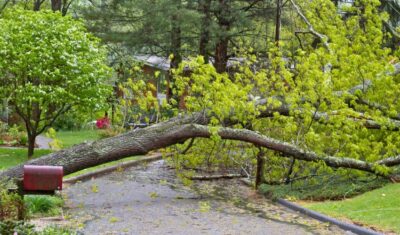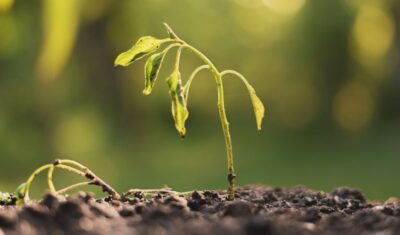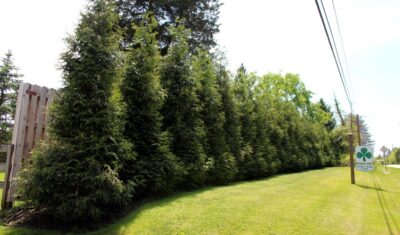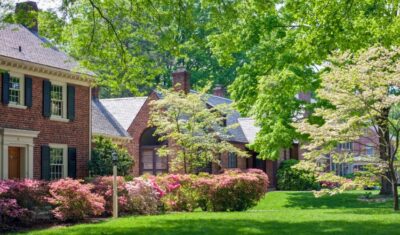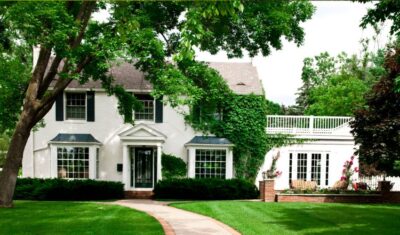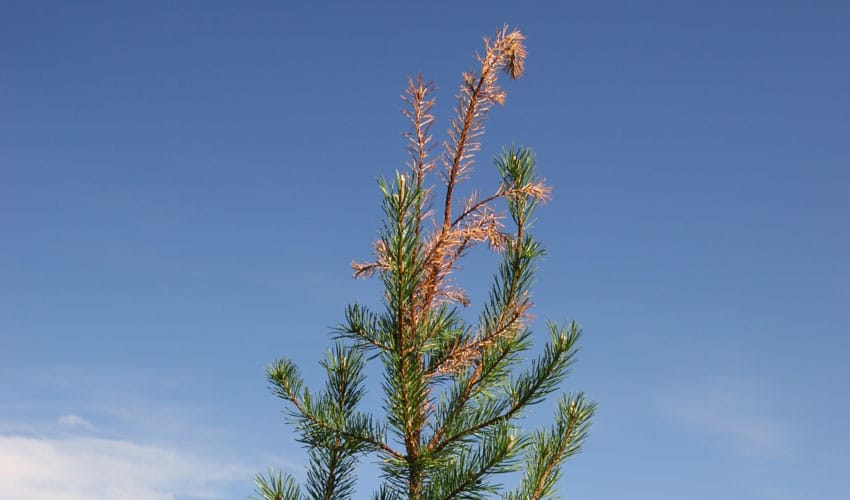
Is the top of your pine tree wilting, turning brown and/or dying?
If so, the culprit is probably the White Pine Weevil (Pissodes strobi).
Trees Susceptible to Damage
Don’t let the name fool you – this native insect doesn’t only attack Eastern white pines, but also goes after Scots, Austrian, jack, red, and pitch pines, as well as Douglas fir and all spruces (including Colorado blue, Norway and Serbian spruce). It’s also called the Engelmann Spruce Weevil, or simply Spruce Weevil.
The white pine weevil is found throughout much of the country, ranging from the east coast west into the Rockies.
Identifying White Pine Weevil Damage
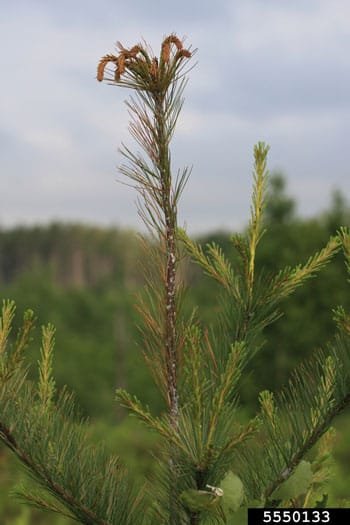
Damaged leader caused by white pine weevil. Image: Steven Katovich, USDA Forest Service, Bugwood.org
The weevil has been here in Northeast Ohio for some time but has been particularly prevalent this year, with many damaged trees seen throughout our area.
Damage caused by white pine weevil is quite distinctive.
In spring (around the time that forsythia blooms), female weevils start feeding and laying eggs on branch tips at the top of their preferred tree hosts (usually, the “terminal leader” – the tallest, vertical part of the tree). In the process, they bore small holes that bleed sap. Droplets of this shiny, sticky substance below branch tips is the first sign of the weevil’s presence you’ll probably notice.
Once eggs hatch in early summer, the grub-like larvae tunnel under the bark to feed, cutting off the flow of water and nutrients to the branch tips and eventually killing them. This is when you’ll see the tops of pines, Douglas fir and spruce trees wilting and turning brown. You may also notice that the tip has a curved “shepherd’s crook” appearance.
In fall, the next generation of adult weevils emerges to feed and mate, causing even more damage.
Left unchecked, weevils can kill a small tree (under 3 feet) and stunt the growth of larger trees. After several years of white pine weevil damage, evergreen trees are left deformed – they’re often called “cabbage trees” because of their squat appearance and multiple terminal leaders.
How to Control White Pine Weevil
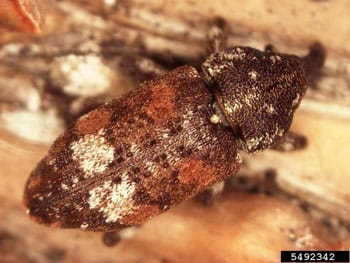
White pine weevil (adult). Image: Sandra Jensen, Cornell University, Bugwood.org
There are several ways to control the spread of white pine weevil.
Spring Spraying
Trees can be sprayed in spring with an insecticide that kills the female weevils and prevents them from laying eggs. A single weevil may lay up to 100 eggs so it’s important to stop them quickly. For this to be effective, infested trees must be identified before tip die-back, so be on the lookout for the oozing sap that announces the presence of female weevils.
The entire leader (and any affected lateral branches) of the tree must be thoroughly covered with insecticide. At this time, sprays are not available to property owners so call in a licensed pesticide applicator with the equipment and training to spray them safely and completely.
Summer Pruning
In summer, affected leaders can be pruned back to remove parts likely to contain weevil larvae (below the discolored part). In larger trees, pruning is not a realistic DIY option so call in an experienced Certified Arborist to do the job safely and correctly. Removing the terminal leader can also result in a somewhat disfigured tree if multiple replacement leaders grow in its place, so a Certified Arborist will use specific pruning techniques to minimize the likelihood of that happening.
Fall Soil Treatment
Before the ground freezes in fall, a systemic insecticide can be used that will prevent weevil damage the following spring. We use a soil injection so there’s no spraying involved, and the fall application gives the tree time to absorb the insecticide and move it up to the leader where weevils feed in spring.
If you notice any of the signs of white pine weevil infestation, call us right away. We’ll inspect the tree to confirm the presence of these destructive weevils and recommend the appropriate treatment for your situation.
Featured image: Steven Katovich, USDA Forest Service, Bugwood.org
Schedule a Property Inspection
If you suspect white pine weevil on your trees or want to check for any additional pest or disease issues on your plants or trees, contact Independent Tree. Our plant health care professionals will assess your property, inform you of anything that they find, point out potential future issues, and give advice on how to prevent or treat insect pests or diseases.Recent Articles
Topics
About The Author

STAY IN THE LOOP
WITH OUR
LATEST UPDATES
"*" indicates required fields

